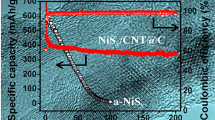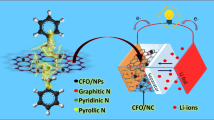Abstract
Modified Si nanoparticles were investigated as an anode material for lithium-ion batteries. The Si nanoparticle surfaces were modified with conductive, N-doped carbon layers and prepared by a simple pyrolysis process using an ionic liquid that contained nitrogen. After the heat treatment, the N-doped carbon layers were uniformly coated onto the Si nanoparticles. The smooth carbon layers connected the Si nanoparticles without any morphological changes. Si nanoparticles containing 34 wt.% N-doped carbon exhibited the best electrochemical performance with a capacity of ∼1145 mAh g−1 and excellent capacity retention over 100 cycles. The high electrochemical performance was attributed to the N-doped carbon layers that improved the electrical conductivity and minimized the volume expansion associated with the alloy during cycling.






Similar content being viewed by others
References
Notter DA, Gauch M, Widmer R, Wäger P, Stamp A, Zah R, Althaus HJ (2010) Contribution of Li-ion batteries to the environmental impact of electric vehicles. Environ Sci Technol 44:6550–6556
Larcher D, Tarascon JM (2015) Towards greener and more sustainable batteries for electrical energy storage. Nat Chem 7:19–29
Thackeray MM, Wolverton C, Isaacs ED (2012) Electrical energy storage for transportation-approaching the limits of, and going beyond, lithiumion batteries. Energy Environ Sci 5:7854–7863
Wu H, Cui Y (2012) Designing nanostructured Si anodes for high energy lithium ion batteries. Nano Today 7:414–429
Bogart TD, Chockla AM, Korgel BA (2013) High capacity lithium ion battery anodes of silicon and germanium. Curr Opin Chem Eng 2:286–293
Zhou R, Fan R, Tian Z, Zhou Y, Guo H, Kou L, Zhang D (2016) Preparation and characterization of core–shell structure Si/C composite with multiple carbon phases as anode materials for lithium ion batteries. J Alloys Compd 658:91–97
Chakrapani V, Rusli F, Filler MA, Kohl PA (2012) Silicon nanowire anode: Improved battery life with capacity-limited cycling. J Power Sources 205:433–438
Ge M, Rong J, Fang X, Zhou C (2012) Porous doped silicon nanowires for lithium ion battery anode with long cycle life. Nano Lett 12:2318–2323
Zhou XY, Tang JJ, Yang J, Xie J, Ma LL (2013) Silicon@carbon hollow core–shell heterostructures novel anode materials for lithium ion batteries. Electrochim Acta 87:663–668
Allcorn E, Kim SO, Manthiram A (2015) Thermal stability of active/inactive nanocomposite anodes based on Cu2Sb in lithium-ion batteries. J Power Sources 299:501–508
Xue DJ, Xin S, Yan Y, Jiang KC, Yin YX, Guo YG, Wan LJ (2012) Improving the electrode performance of Ge through Ge@C core-shell nanoparticles and graphene networks. J Am Chem Soc 134:2512–2515
Jeong G, Kim JG, Park MS, Seo M, Hwang SM, Kim YU, Kim YJ, Kim JH, Dou SX (2014) Core-shell structured silicon nanoparticles@TiO2-x/carbon mesoporous microfiber composite as a safe and high-performance lithium-ion battery anode. ACS Nano 8:2977–2985
Zhou M, Cai T, Pu F, Chen H, Wang Z, Zhang H, Guan S (2013) Graphene/carbon-coated Si nanoparticle hybrids as high-performance anode materials for Li-ion batteries. ACS Appl Mater Interfaces 5:3449–3455
Song J, Chen S, Zhou M, Xu T, Lv D, Gordin ML, Long T, Melnyk M, Wang D (2014) Micro-sized siliconcarbon composites composed of carbon-coated sub-10 nm Si primary particles as high-performance anode materials for lithium-ion batteries. J Mater Chem A 2:1257–1262
Lee JS, Wang XQ, Luo HM, Baker GA, Dai S (2009) Facile ionothermal synthesis of microporous and mesoporous carbons from task specific ionic liquids. J Am Chem Soc 131:4596–4597
Ryu MH, Jung KN, Shin KH, Han KS, Yoon S (2013) High performance N–doped mesoporous carbon decorated TiO2 nanofibers as anode materials for lithium-ion batteries. J Phys Chem C 117:8092–8098
Paraknowitsch JP, Zhang J, Su D, Thomas A, Antonietti M (2010) Ionic liquids as precursors for nitrogen-doped graphitic carbon. Adv Mater 20:87–92
Nanda J, Datta MK, Remillard JT, O’Neill A, Kumta PN (2008) In situ raman microscopy during discharge of a high capacity silicon–carbon composite Li-ion battery negative electrode. Electrochem Commun 11:235–237
Park KS, Benayad A, Kang DJ, Doo SG (2008) Nitridation driven conductive Li4 Ti5 O12 for lithium ion batteries. J Am Chem Soc 130:14930–14931
Zukalova M, Prochazka J, Bastl Z, Duchoslav J, Rubacek L, Havlicek D, Kavan L (2010) Facile conversion of electrospun TiO2 into titanium nitride/oxynitride fibers. Chem Mater 22:4045–4055
Zhao L, Hu YS, Li H, Wang Z, Chen L (2011) Porous Li4 Ti5 O12 coated with N-doped carbon from ionic liquids for Li-ion Batteries. Adv Mater 23:1385–1388
Acknowledgments
This research was supported by the Ministry of Trade, Industry and Energy (MOTIE), Korea Institute for Advancement of Technology (KIAT) through the Encouragement Program for The Industries of Economic Cooperation Region) (No. G02A01210004401) and the National Research Foundation of Korea (NRF) grant funded by the Korea government (MSIP) (No. 2015R1C1A1A01051733).
Author information
Authors and Affiliations
Corresponding authors
Rights and permissions
About this article
Cite this article
Sasidharachari, K., Na, BK., Woo, SG. et al. Facile conductive surface modification of Si nanoparticle with nitrogen-doped carbon layers for lithium-ion batteries. J Solid State Electrochem 20, 2873–2878 (2016). https://doi.org/10.1007/s10008-016-3291-7
Received:
Revised:
Accepted:
Published:
Issue Date:
DOI: https://doi.org/10.1007/s10008-016-3291-7




